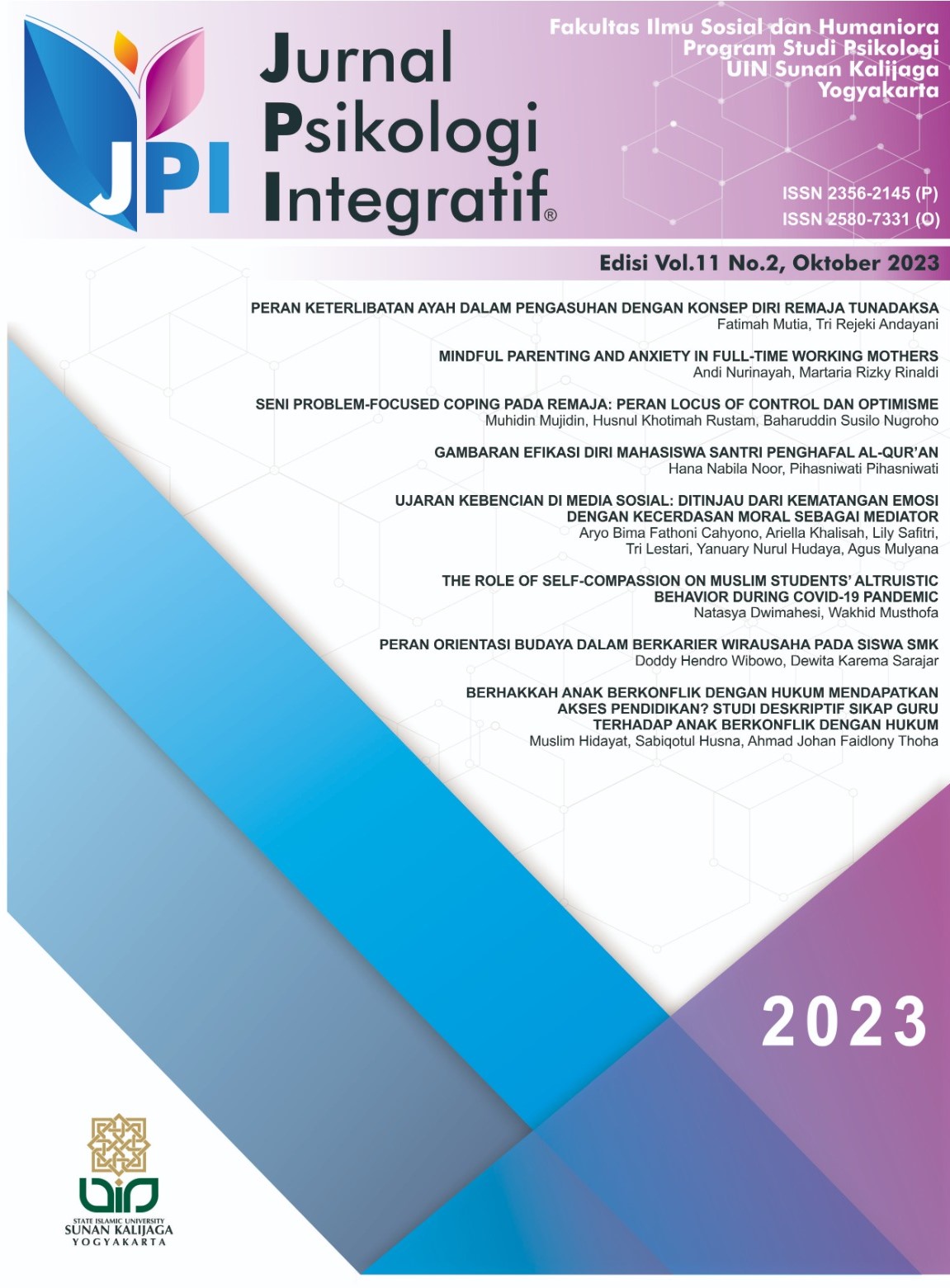Berhakkah Anak Berkonflik dengan Hukum Mendapatkan Akses Pendidikan? Studi Deskriptif Sikap Guru terhadap Anak Berkonflik dengan Hukum
DOI:
https://doi.org/10.14421/jpsi.v11i2.2954Keywords:
attitudes, teachers, children in conflict with the lawAbstract
Cases of children in conflict with the law continue to increase in numbers. Teachers' attitudes and views towards children in conflict with the law (ABH) requires empirical study, especially regarding how ABH has the right to continue their education. This study aims to explore teachers' attitudes towards ABH regarding whether they have the right to continue their education. The method used in this research is a quantitative survey with a total of 134 teachers (mean age 36.46). The data collection instrument was a teacher's attitude questionnaire towards children in conflict with the law which was compiled based on cognitive, affective and behavioral aspects (Jain, 2014). The results of the study revealed that teachers' attitudes towards ABH tended to vary, depending on the status of the process being undertaken by students who were involved in criminal cases. The status of ABH who have been sentenced to prison terms is the status that gets the lowest percentage related to the decision and attitude of the teacher considering that ABH has the right to continue school, and gets the highest percentage related to the teacher feeling ashamed when their student is ABH. As for the status of receiving coaching sanctions in social institutions, it is in the context of ABH status that the highest percentage gets from teachers to accept them back and continue their education. Although not all respondents in this study understood the definition of ABH and laws related to ABH, they expressed their attitude of accepting ABH as students with different variations in the context of ABH status itself. The results of this study can provide practical implications in the context of how educational institutions and their instruments can design policies and counseling related to how teachers and other educators respond to children in conflict with the law.Downloads
References
Baron, Robert A., & Nyla R. Branscombe. (2015). Social Psychology 13th Edition. New Jersey: Pearson Education.
Crisp, R. J. & Turner, R. N. (2010). Essential Social Psychology: 2nd Edition. London, England: Sage
Danawiharja, Y.L. (2020). Analisis Yuridis Penerapan Diversi Terhadap Anak yang Berhadapan dengan Hukum Dihubungkan dengan Peraturan Mahkamah Agung No 4 Tahun 2014 tentang pedoman Pelaksanaan Diversi dalam Sistem Peradilan Pidana Anak. Aktualita Jurnal Hukum. Volume 3 No 2. https://doi.org/10.29313/aktualita.v0i0.6325
DeFleur, M. L., & Westie, F. R. (1963). Attitude as a scientific concept. Social Forces, 42(1), 17-31.
Ferdiawan, R.P., Santoso, M.B., Darwis, R.S. (2020). Hak Pendidikan Bagi Anak Berhadapan (Berkonflik) dengan Hukum. Jurnal Kolaborasi Resolusi Konflik, Volume 2, No 1, Hal 1-73
Hambali, A.R. (2019) Penerapan Diversi Terhadap Anak yang Berhadapan Dengan Hukum Dalam Sistem Peradilan Pidana. Jurnal Ilmiah, Kebijakan Hukum. Volume 13, No 1, Hal 15-30. DOI: http://dx.doi.org/10.30641/kebijakan.2019.V13.15-30.
Jain, V. (2014). 3D model of attitude. International journal of advanced research in management and social sciences, 3(3), 1-12.
KPAI. (2013). Undang - Undang (UU) RI No.11 Tahun 2012 Tentang Sistem Peradilan Anak | Komisi Perlindungan Anak Indonesia (KPAI) www.kpai.go.id/hukum/undang-undang -uu-ri-no-11-tahun- 2012-tentang-sistem-peradilan-anak
Margono. (2004). Metodologi Penelitian Pendidikan, Jakarta: Rineka Cipta.
Pahlevi, R. (2022). Ini Jumlah Anak-Anak yang Jadi Pelaku Kekerasan di Indonesia. Retrieved from https://databoks.katadata.co.id/ datapublish/2022/07/29/ini-jumlah-anak-anak-yang-jadi-pelaku-kekerasan-di-indonesia
Pemerintah Indonesia. (2002). Undang-Undang Republik Indonesia Nomor 23 Tahun 2002 tentang Perlindungan Anak. Lembaran Negara Republik Indonesia Tahun 2002 Nomor 109. Jakarta: Sekretariat Negara.
Putra, B.G.B, Swardhana, G.M, Purwani, S.P.M.E. (2018). Anak Berhadapan dengan Hukum Ditinjau dari Aspek Kriminologi (Studi Kasus Di Lembaga Pembinaan Khusus Anak Kelas II Karangasem) Skripsi. Universitas Udayana.
Riyanto, F.A., Muhammad, A. (2021). Implementasi Hak Pendidikan pada Anak Berhadapan (Berkonflik) dengan Hukum di Lembaga Pembinaan KhususAnak Kelas I Kutoarjo. Jurnal Justitia, Volume 8 No 6
Garcia-Santillan, A., Moreno-Garcia, E., Carlos-Castro, J., Zamudio-Abdala, J. H., & Garduno-Trejo, J. (2012). Cognitive, affective and behavioral components that explain attitude toward statistics. Journal of mathematics research, 4(5), 8.
Unicef. (1989). Convention on the Rights of the Child.
United Nations. (1985). United Nations Standard Minimum Rules for the Administration of Juvenile Justice ("The Beijing Rules"): resolution / adopted by the General Assembly.
Wahyudhi, D. (2015) Perlindungan Terhadap Anak Yang berhadapan dengan Hukum Melalui Pendekatan restorative Justice . Jurnal Ilmu Hukum. Hal 143-163.men
Wicker, A. W. (1969). Attitudes versus actions: The relationship of verbal and overt behavioral responses to attitude objects. Journal of Social issues, 25(4), 41-78.
Downloads
Additional Files
Published
Issue
Section
License
Authors who publish with this journal agree to the following terms:- Authors retain copyright and grant the journal right of first publication with the work simultaneously licensed under a Creative Commons Attribution License that allows others to share the work with an acknowledgement of the work's authorship and initial publication in this journal.
- Authors are able to enter into separate, additional contractual arrangements for the non-exclusive distribution of the journal's published version of the work (e.g., post it to an institutional repository or publish it in a book), with an acknowledgement of its initial publication in this journal.
- Authors are permitted and encouraged to post their work online (e.g., in institutional repositories or on their website) prior to and during the submission process, as it can lead to productive exchanges, as well as earlier and greater citation of published work (See The Effect of Open Access).


.png)












